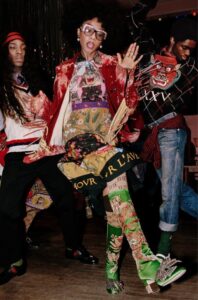The recent appointment of Demna Gvasalia as the new creative director of Gucci marked a disruptive turning point for the historic Florentine fashion house. A meeting of two visions: on one hand, the eclectic and baroque elegance of Gucci, on the other the conceptual deconstruction and industrial language of Demna, already acclaimed for his revolutionary work by Clothing to Balenciaga.

In 2015, his appointment as creative director of Balenciaga confirmed his talent for transformation. Demna combined the house's couture heritage with a hyper-contemporary sensibility, bringing oversized silhouettes, sculpted shoulders and technical materials to the runway, all infused with explicit social commentary. His industrial aesthetic, essential yet conceptual, has made Balenciaga one of the most discussed – and sold – brands of the last decade.
Gucci: between past and vision
In the years 2015-2022, under the creative direction of Alexander Michael, Gucci has experienced a period of enormous turmoil, becoming a symbol of romantic maximalism and fluid identity. Vintage-inspired clothing, cultured cultural references, genderlessness and surrealism have redefined the brand's image, making it a point of reference for Gen Z and inclusive fashion. However, after Michele's exit and the brief passage of Sabato De Sarno, the brand has shown the need for a new creative direction capable of maintaining critical attention and commercial potential
Destroy to create
The union between Demna's brutalist and conceptual universe and Gucci's sumptuous legacy opens up fascinating scenarios. We could expect a Gucci more essential and sharp, where irony and social criticism coexist with historical codes of the house such as monograms, green-red-green, GG leather and equestrian motifs. In this context, Demna could deconstruct the Gucci iconography, reinterpreting it with architectural forms, technical materials and a new emotional narrative.
His sensitivity to everyday life and social discomfort could translate into a Gucci more tied to urban reality, while maintaining a strong symbolic charge. Fashion would thus become a tool for political and individual expression, without losing sight of the allure of luxury. A new approach to sustainability and craftsmanship, revisited with a contemporary and disillusioned gaze, cannot be ruled out either.
A new chapter for the maison
Demna will officially take over the role at July 2025, after his last collection for Balenciaga in Paris. His challenge will be to keep Gucci relevant in a constantly changing market, without betraying the brand's historical roots. Expectations are high, but if there is a figure capable of subverting and reinventing with coherence, it is Demna.
His Gucci will not only be an exercise in style, but a cultural, social and visual exploration: a new language that mixes glamour with discomfort, tradition with anti-luxury, dream with reality.













